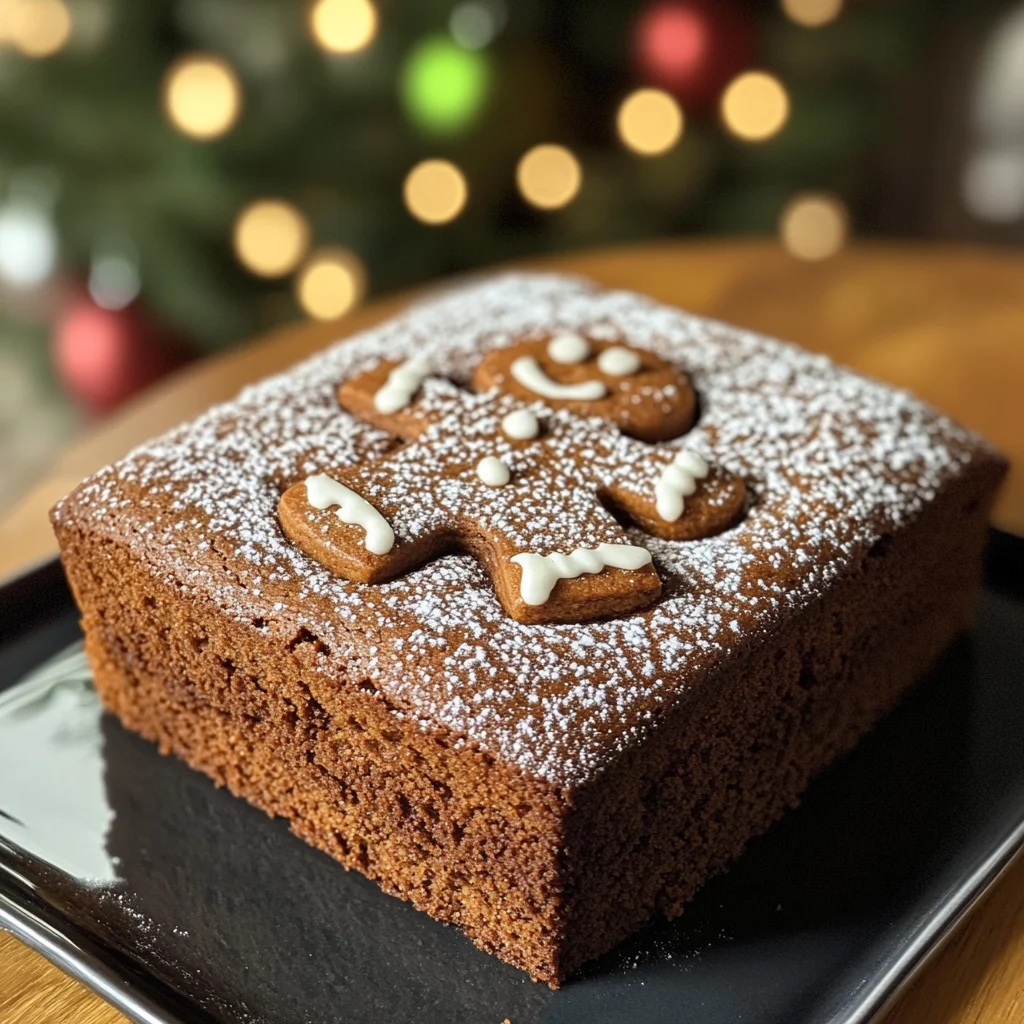This Easy Christmas Gingerbread Cake is cozy, fragrant, and unbelievably simple—perfect when you want festive flavor without fuss. Warm spices and molasses bake into a tender, plush crumb that makes the whole kitchen smell like the holidays. With about 15 minutes of prep and a quick bake, it’s a sweet little project you can pull off on a weeknight.
It serves about 4 generously (or 6 smaller squares) and clocks in around 45 minutes from start to finish. I’ve included a bright lemon drizzle option for contrast, but it’s just as lovely dusted with powdered sugar or topped with a dollop of whipped cream. Let’s bake some cheer.
Why I Love These
Deep gingerbread flavor meets soft, tender crumb in under an hour.
The batter comes together in one bowl with pantry staples and zero special equipment.
It’s my go-to when I need a festive dessert for a small gathering or cozy night in.

Ingredients
- 3/4 cup butter, melted
- 2 cups brown sugar
- 2 cups molasses
- 1 cup warm water
- 1 cup buttermilk, room temperature
- 3 large eggs
- 2 tablespoons ground ginger
- 1 tablespoon ground cinnamon
- 3/4 teaspoon ground cloves
- 1 1/2 teaspoons salt
- 1 teaspoon baking soda
- 1 1/2 teaspoons baking powder
- 4 cups all-purpose flour
How To Make
- Preheat the oven to 350°F (175°C). Grease and line an 8-inch square pan with parchment, leaving a small overhang for easy lifting. This helps prevent sticking and gives clean edges.
- Whisk the dry mix: In a medium bowl, whisk all-purpose flour, baking soda, fine sea salt, ground ginger, ground cinnamon, ground cloves, and ground nutmeg until evenly combined and no spice clumps remain.
- Make the wet base: In a large bowl, whisk melted (but not hot) unsalted butter with dark brown sugar and molasses until glossy and smooth. If the mixture looks grainy, keep whisking—heat from the butter will dissolve the sugar.
- Whisk in large eggs one at a time until the batter is silky and thick. If it looks slightly curdled, don’t worry—it will smooth out once the dry ingredients go in.
- Stir in milk, hot coffee, and vanilla extract. The coffee amplifies the gingerbread notes without adding coffee flavor. Mixture will be fluid—that’s ideal for a plush, moist crumb.
- Combine: Add the dry mix to the wet and gently whisk or fold just until no streaks of flour remain. Avoid overmixing to prevent a tough cake. Let the batter rest 5 minutes to hydrate the flour and settle bubbles.
- Fill and bake: Pour batter into the prepared pan and tap once to release large air bubbles. Bake 25 to 30 minutes, rotating the pan once midway. It’s done when the top is domed and springy, edges pull slightly from the sides, and a toothpick comes out with a few moist crumbs (not wet batter).
- Cool: Set the pan on a rack and cool 10 minutes, then lift the cake out and cool another 10 to 15 minutes. If the center dips, it often means underbaking or opening the oven early—bake a few minutes longer next time and avoid peeking before 20 minutes.
- Finish: For a quick lemon drizzle, whisk powdered sugar with lemon juice until thick and pourable, then zigzag over the warm cake. Alternatively, simply dust with powdered sugar. Slice into four generous squares and serve warm with whipped cream or vanilla ice cream.
Nutrition
This gingerbread cake is a festive, moderately sweet treat with a moist crumb, offering a balanced profile for a dessert: carbs for energy, moderate fat for tenderness, and a reasonable portion size perfect for small gatherings.
Molasses provides trace minerals like iron and potassium, while warming spices such as ginger and cinnamon add antioxidants. To lighten the cake, swap part of the butter with unsweetened applesauce or use milk with a lower fat content; for a richer bake, add a touch more butter or finish with a cream cheese frosting instead of a lemon glaze.
Allergens to note include gluten (flour), eggs, and dairy (butter, milk). Make it friendly to more eaters by using a 1:1 gluten-free baking flour, plant-based milk and dairy-free butter, and an egg substitute like flax eggs; just watch bake time, as moisture levels may vary.
Tips & Variations
- Make-ahead: Whisk dry ingredients in advance and store airtight for up to a week; the baked cake keeps well and tastes even better the next day as the spices bloom.
- Citrus twist: Add orange zest to the batter or swap the lemon drizzle with an orange glaze; for extra indulgence, fold in chopped candied ginger or dark chocolate chunks.
- Diet-friendly: Use a gluten-free 1:1 flour blend, dairy-free butter and milk, and flax eggs for an egg-free version—bake until the same visual cues appear, adding a few extra minutes if needed.
Ways To Serve Them
- With a tart lemon drizzle and a light dusting of powdered sugar
- Warm with vanilla ice cream or cinnamon-spiced whipped cream
- Alongside hot coffee, chai, or mulled wine
- Finished with a thin cream cheese frosting for a richer holiday dessert
Proper Storage
- Fridge: Cool completely, then store slices in an airtight container with parchment between layers for up to 4 days.
- Freezer: Wrap individual squares tightly in plastic, then place in a freezer bag for up to 2 months; thaw overnight in the fridge.
- Reheat: Warm slices in a 300°F (150°C) oven for 8 to 10 minutes or microwave in short bursts, covering to retain moisture; add a touch of fresh glaze after reheating if desired.

Ingredients
- 3/4 cup butter, melted
- 2 cups brown sugar
- 2 cups molasses
- 1 cup warm water
- 1 cup buttermilk, room temperature
- 3 large eggs
- 2 tablespoons ground ginger
- 1 tablespoon ground cinnamon
- 3/4 teaspoon ground cloves
- 1 1/2 teaspoons salt
- 1 teaspoon baking soda
- 1 1/2 teaspoons baking powder
- 4 cups all-purpose flour
Steps
- Preheat the oven to 350°F (175°C). Grease and line an 8-inch square pan with parchment, leaving a small overhang for easy lifting. This helps prevent sticking and gives clean edges.
- Whisk the dry mix: In a medium bowl, whisk all-purpose flour, baking soda, fine sea salt, ground ginger, ground cinnamon, ground cloves, and ground nutmeg until evenly combined and no spice clumps remain.
- Make the wet base: In a large bowl, whisk melted (but not hot) unsalted butter with dark brown sugar and molasses until glossy and smooth. If the mixture looks grainy, keep whisking—heat from the butter will dissolve the sugar.
- Whisk in large eggs one at a time until the batter is silky and thick. If it looks slightly curdled, don’t worry—it will smooth out once the dry ingredients go in.
- Stir in milk, hot coffee, and vanilla extract. The coffee amplifies the gingerbread notes without adding coffee flavor. Mixture will be fluid—that’s ideal for a plush, moist crumb.
- Combine: Add the dry mix to the wet and gently whisk or fold just until no streaks of flour remain. Avoid overmixing to prevent a tough cake. Let the batter rest 5 minutes to hydrate the flour and settle bubbles.
- Fill and bake: Pour batter into the prepared pan and tap once to release large air bubbles. Bake 25 to 30 minutes, rotating the pan once midway. It’s done when the top is domed and springy, edges pull slightly from the sides, and a toothpick comes out with a few moist crumbs (not wet batter).
- Cool: Set the pan on a rack and cool 10 minutes, then lift the cake out and cool another 10 to 15 minutes. If the center dips, it often means underbaking or opening the oven early—bake a few minutes longer next time and avoid peeking before 20 minutes.
- Finish: For a quick lemon drizzle, whisk powdered sugar with lemon juice until thick and pourable, then zigzag over the warm cake. Alternatively, simply dust with powdered sugar. Slice into four generous squares and serve warm with whipped cream or vanilla ice cream.
Notes
- Make-ahead: Whisk dry ingredients in advance and store airtight for up to a week; the baked cake keeps well and tastes even better the next day as the spices bloom.
- Citrus twist: Add orange zest to the batter or swap the lemon drizzle with an orange glaze; for extra indulgence, fold in chopped candied ginger or dark chocolate chunks.
- Diet-friendly: Use a gluten-free 1:1 flour blend, dairy-free butter and milk, and flax eggs for an egg-free version—bake until the same visual cues appear, adding a few extra minutes if needed.
